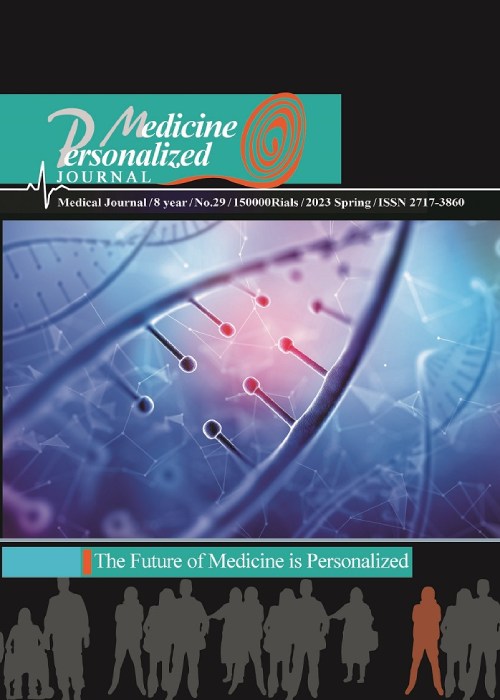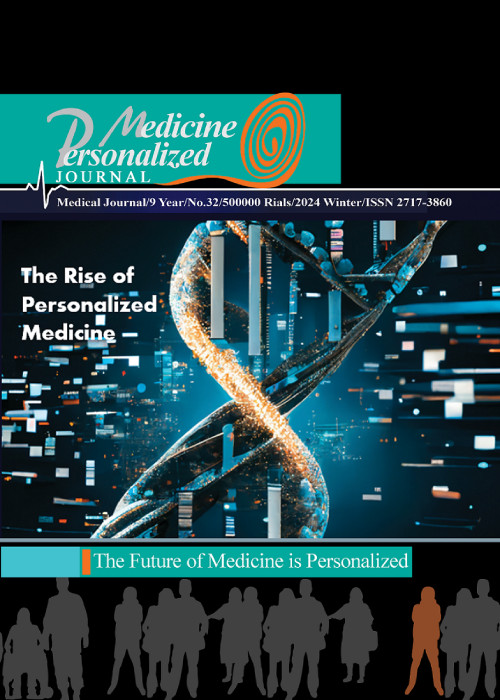فهرست مطالب

Personalized Medicine Journal
Volume:8 Issue: 29, Spring 2023
- تاریخ انتشار: 1402/03/30
- تعداد عناوین: 6
-
Pages 1-7Preimplantation genetic diagnosis is recognized as an effective approach to rule out embryos with abnormal chromosomes in hopes of increasing the chances of a successful pregnancy. The objective of this study is to evaluate the association between types of single cell (blastomere) chromosomal aneuploidy and female partner age using Next Generation Sequencing technique. This study showed that 70.80% of tested samples had abnormal chromosomal complementation, regardless of maternal age or complexity of the abnormality present.Keywords: Next Generation Sequencing, Genetics, Blastomeres, Aneuploidy, Chromosomes
-
Pages 8-13
It has been known for quite some time that gut microbiota plays an important role in human health and illness. Recent years have seen a surge in interest in the human gut microbiota, and the advent of metagenomic investigations has greatly aided our understanding of the resident species and their potential uses. The human digestive tract is home to billions of bacteria, making up the varied gut microbiota. At birth, the gut microbiome begins to take shape and proliferate, and throughout life, numerous genetic, dietary, and environmental variables will shape and multiply this community. Alterations to the gut microbiota's structure and function may affect digestion, metabolism, and the immune system. Meanwhile, personalized medicine, a new therapeutic approach, has opened a new door in the medical sciences, and the link between the microbiome and personalized medicine is one of the most intriguing areas of study going forward. Since the link between this two axis is new, there are few research on it. Therefore, in this review study, the relationship between the gut microbiome, drug interactions, disease progression, and personalized medicine has been discussed.
Keywords: Personalized Medicine, Microbiome, health, Therapeutic strategies -
Pages 14-24The aim of this study is to investigate the attitude, beliefs, and perceptions among undergraduate and graduate students toward precession medicine (PM) and pharmacogenomics (PGx) practice. A cross-sectional survey is conducted amongst students from different universities in Bangladesh.The results of the survey showed that the majority of students had a positive attitude towards precision medicine and pharmacogenomics, perceiving it as a means to improve diagnosis and treatment accuracy. Furthermore, many students also expressed a willingness to learn more about precision medicine and pharmacogenomics, suggesting that there is potential for these practices to be utilized in Bangladesh. Particularly in this study, 337 students from life science and relevant programs participated. From this study, it is shown that 84% of graduate students and 74% of undergraduate students thought PM is a promising healthcare model. In addition, 39% of students are highly encouraged to pursue their post-graduation in the subject areas of PGx and PM to support patients. The majority (62%) thought that patient privacy was the ethical concern most closely related to pharmacogenomic testing, while 19% of respondents thought that data confidentiality was the key issue. The results provide insight into the potential of precision medicine and pharmacogenomics in Bangladesh and suggest that further research into the attitudes of healthcare professionals should be conducted in order to take full advantage of the potential of these practices.Keywords: pharmacogenomics, Precision Medicine, Ethical, legal, Social implications, Genetic Testing
-
Pages 25-30
Due to the increasing level of bacterial antibiotic resistance (AB), it is now required to modify the dosage for customized medication using therapeutic drug monitoring. The creation of a novel treatment for clinical use, such as situations of bacterial resistance, has been hailed as a feasible, affordable, and quick alternative by the pharmaceutical industry. Therefore, the current research sought to examine the myorelaxant Thiocolchicosidum's antibacterial activity against bacterial strains. Staphylococcus aureus ATCC 25923, Escherichia coli ATCC 25922, Proteus mirabilis ATCC 25933, and Pseudomonas aeruginosa ATCC 27853 were used as the bacteria in an in vitro experimental study, along with the protocols for antibacterial activity screening, minimum inhibitory concentration (MIC), and characterization of antibacterial activity. Thiocolchicosidum, at levels varying from 0.48 to 1000 µg/mL, was the chemical. The only bacterial strains that showed any sensitivity to the myorelaxant were E. coli and P. aeruginosa, both of which had MICs of 500 µg/mL and 1000 µg/mL, respectively. Thiocolchicosidum demonstrated a bacteriostatic effect in the antimicrobial characterization test. Therefore, despite the fact that this medication is already considered safe for human use, no discernible antibacterial effects were shown in common bacterial strains. Therefore, research is required to determine how it differs from other microbes, such as various kinds of bacteria, fungus, and protozoa, in order to rule it out as a potential antibiotic material for use in industry.
Keywords: Bacterial resistance, Pharmacology, Thiocolchicosidum -
Pages 31-35
The synovial joints are most affected by the systemic autoimmune inflammatory condition known as rheumatoid arthritis (RA). A unique and underappreciated link exists between rheumatoid vasculitis (RV), an extra-articular symptom of RA, and Inflammatory Aortic Disease (aortitis). In this article, we describe the case of a 64-year-old lady who had RA-associated aortitis and conducted a literature search on the condition. Patients with RA-associated aortitis received an average oral steroid dosage of 40.2 mg/day of prednisolone (PSL). Due to the patient's RV-related symptoms, including epidermal ulceration, a significant rheumatoid factor titer, and a modest PSL dosage significantly alleviated the clinical features, it was assumed that RV also caused our patient's aortitis. Early identification and the start of therapy are crucial since RA-associated aortitis may be lethal if left untreated.
Keywords: Rheumatoid arthritis, Rheumatoid vasculitis, Inflammatory Aortic Disease -
Pages 36-42
Platelets are tiny (2-4 m), anucleate, hematopoietic cells that are discharged into the circulation by bone marrow megakaryocytes. Platelets were formerly thought to be the main agents of hemostasis and thrombosis. Armand Trousseau established a strong link between thrombosis and cancer in 1865. The hypothesis that platelets play many roles in the development of malignancies and in cancer-associated thrombosis is thus supported by a wealth of clinical and experimental data.The functions of tumor-educated platelets (TEPs) in the development of cancer, from primary tumors to subsequent metastatic breakouts, will be covered in this study
Keywords: Cancer, Tumor, Metastatic, Platelets, Growth factor


